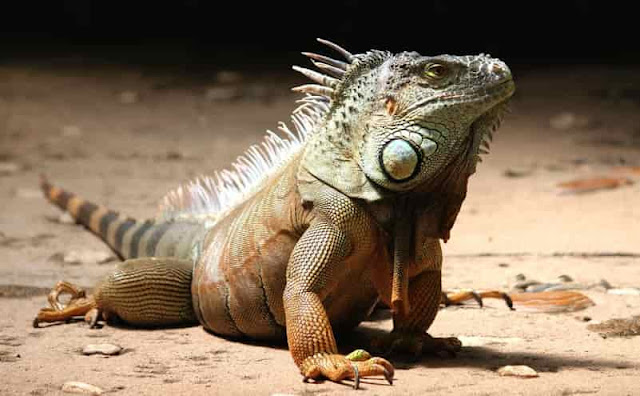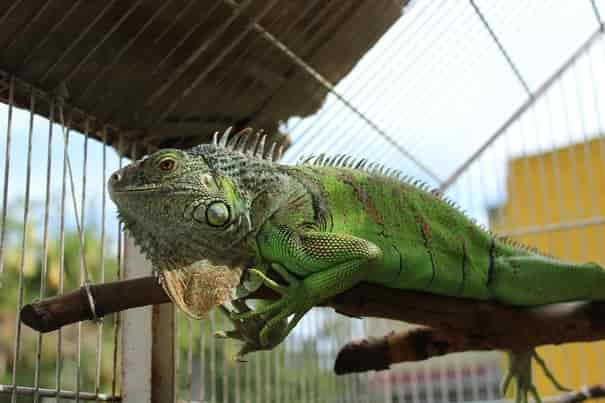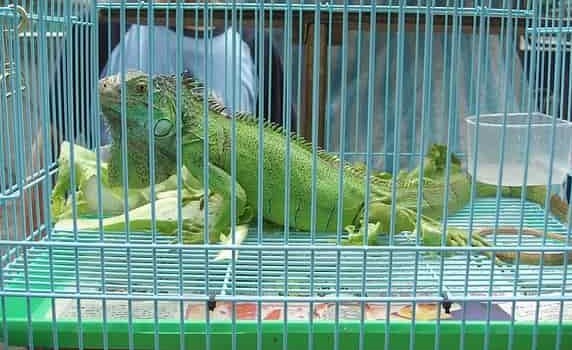Iguana pet
If you wish to get iguana pet, you should tend to or so
It should also have an extra room for water bowls, decorations,
and logs. Logs are ideal to have in a terrarium because they can serve as
climbing areas. However, you may also put plants such as ficus shrubs, spider
plants, and hibiscus plants. You can put real plants or fake plants; Just make sure that the iguanas do not eat them. Do not put in sharp objects or
any material that can be harmful to the iguanas such as wood chips, gravel, and
sand.
In addition, you should to it that you adjust the
temperature and lighting inside the tank or terrarium. You should try to mimic
natural iguana habitats by setting up a basking light. Make sure that the
temperature is regulated
Aside from basking light, you may also use ultraviolet
light. Iguanas need UVA and UVB to maintain their health. So, if you cannot
move their tank or terrarium to a place where the sun can shine through it, you
should
Iguana facts
Purchasing your first iguana can be a very exciting thing,
and if you have just done this, you most likely want to give your new friend
the best care possible. One thing you must always remember when caring about
your iguana is that proper iguana are extremely dependent
If an iguanas
1.) If this is your first reptile, then the first thing you
want to do is learn as much information as you can about proper handling. It is
highly recommended that you read as many books as possible on proper handling,
housing, feeding, and overall caring for the iguana. These tropic lizards can
easily succumb to cold weather climates.
If you want your lizard to grow to its maximum size in
captivity, you need to continue learning more about this species. Successful
iguana owners are known to raise their iguanas to a length of up to six feet!
This is absolutely possible for you to do as well if you learn the proper
iguana care information.
2.) Be cautious when researching proper iguana care.
The Internet is an unregulated place and can be extremely misleading. Be
careful when researching blogs or forums as these places contain information
from ordinary people and their opinions.
You should always practice comparing a piece of information
that you find on the internet will be able to internet
3.) Being that they are wild animals, iguanas will tend to
feel stressed when they are transported into their new environments. This
stress can be very damaging to your new pet so it is important to not add any more stress to your iguana.
You do not want to attempt to the people around it it is tamed
4.) This should come as no surprise, but your new iguana is
most likely going to need medical treatment in the future . It is a good idea to
locate beforehand, a good veterinarian that specializes in reptiles or exotic
animals in your area.
5.) The consists of extremely
Iguana food
Green iguanas are exotic animals, and they are very strict
herbivores like grasshoppers and rabbits. Herbivores get their energy from
eating plants. They cannot eat other types of food, only plants. If you ever
see a wild iguana eating an insect, they probably eat accidentally with a leaf
or piece of vegetable. They do not naturally choose to do not typically extremely to also help
You've got to feed fresh food to your iguana. Don't ever is spoiled is spoiled you should
Some of the best foods for iguanas include collard greens,
watercress greens, kale greens, mustard greens, and arugula greens. Over time,
you'll be able to see which types of food your pet likes the best. If your pet
is a picky eater, and it looks like, it is not eating a good variety of food for its
diet, you should just blend them all together and feed the mixture to it. Some
other types of food include nitrogen-rich green beans and bananas. Every once
in a while, you can treat your pet with a raspberry or strawberry. These fruits
are tasty and will not harm your pet at all as long as it is eaten in
moderation. Feeding and taking care of your pet iguana should not be a struggle
as long as you are well informed . If you are interested in buying a pet iguana, surf the net and check out your nearest pet store for more
information.
Care of Iguana
Iguanas are one of the most wonderful pets any individual
can have. The only thing that may hinder an individual from purchasing or
adopting an iguana is the amount of care that must be put into the iguana.
Since iguanas are widely available and affordable, people tend to
think that they are more than qualified to become a parent. It is not
that simple. There is a lot of research and learning that must go into the
subject care of iguana before an individual can decide to own a pet iguana.
Light and Heat
Iguanas love to bask in the sun. It's inevitable. If you
don't provide regular direct sunlight for your iguana, you should at least use
UV lights for them. This way, iguanas can get the vitamin D they need for
processing calcium and they'll be able to enjoy basking.
Iguanas also need extra heat from an outside source. They
are natural cold-blooded creatures, so if they do not have access to the right
amount of heat, their digestion can be negatively affected
Food, Water, and Nutrition
Like any other animal, iguanas must eat. In order for them
to live a long and healthy live, you can't just feed them anything. Since they
are vegetarians, it is advisable that you Go ahead and put purposes
Housing and Bedding
Iguanas should have a small home for itself, like a large
cage or tent. Since iguanas can grow to be fairly large, five to six feet, you
should In order to
Clean Pet and Treatment
You've got to give your iguana a 'bath' and allow him to
play in the water from time to time. The water can help your pet's skin become
moist and clean all the bacterial from his scales and nails. You could
either just feel up your bathtub with room temperature water or place a little
bathing pan in the cage.
Take care of your iguana by getting it regularly checked for
any sicknesses in a vet's office. Once a year is enough for checkups. There are
plenty of signs that could also allow you to know that your iguana might be
sick. For example, if your iguana seems limp and lethargic, it might have a
metabolic bone disease. Sometimes iguanas can be anorexic, have toe are aware
Iguana the animal
Owning an iguana the animal can be really do
Size Potential of Iguanas and Cage Size
Baby iguanas are cute and a small but iguanas actually
They can grow at a rate of two inches per month. Now, it is
weight
Make sure you buy a large cage for your iguana. It won't
stunt their growth but it won't be comfortable for them at all if they are in a
small cage. They'll be stressed
If something happens to the Tail, Nails or Toes
Iguana tails can grow back over the course of a year. If it
breaks off somewhere closer to the body, then the tail might be shorter than it
was before. It probably won't be the same color either, but iguana tails do is still able to
Iguana Breeding Season!
The iguana's mating season is during the late wintertime. By
the time it's early spring, the eggs are ready to be laid
Iguana cage
Although controversial, Iguanas are still among the
most popular animals that are being captured and bred. In fact, these creatures
are often imported South America .
Breeders typically make money out of iguana nests. They sell the baby and breed the adults. However, you should be aware that
For instance, building an iguana cage, nests, and breeding iguanas is
fun and profitable. Even if iguanas are usually sold pretty good amount of money. However, you should the
Make sure that you provide them with water, proper food, and
housing. Only those who are fit and healthy can survive. If you want to earn a
decent amount of money from selling iguanas, see to it that you take care of
these creatures well. When building an iguana nest, consider various materials
such as soil and sand. You can use pure potting soil, pure-play sand,
or half play sand and half potting soil.
Among these options, pure-play sand is the best. Using pure
play sand would make digging and burying eggs easier for the female iguana.
Also, not like with potting soil, play sand does not make the iguana filthy.
The eggs laid on play sand remain nice and clean; Hence ,
Regularly removing and discarding feces and uneaten
food will keep the reptiles free from diseases. In addition, remember to place
male and female iguanas together, especially during the mating season. Group
them according to ratio and size. It is ideal to have one male iguana and two
or more female iguanas in a nest. You notice that male iguanas are smaller
than females. This is because the female iguana might kill the male if it is
bigger than her.
You should also monitor the laying of eggs in
the iguana nests. Sometimes in which a female iguana fails to you should x be stuck
You should also ensure that the nest is safe to
dwell in. It should not contain objects that can cause the iguanas to have
scratches, cuts, abrasions, and other injuries. It should also be able to hold
up to two hundred pounds of soil. You should also put in a play area for the
iguana. This does not have to be made
Facts About
In its natural habitat, this animal will spend its day
feeding and soaking in enough sunlight at choice spots where predators can best
be avoided is seen is kept type of
There are many features that these exotic lizards make
them the favorite of many pet owners. Its bright green color green The fact that
These exotic lizards are born from eggs and as the time they
hatch from these eggs, they should measure about 6-8 inches in length
in length begins to set their mood as well as the temperature and the overall
living condition in the environment or habitat they are found
An adult iguana has a peculiar appearance with a dewlap or a
flap of skin found hanging down underneath the chin. This skin fold is
particularly is sometimes called it is associated It is also known some regulation of
the animal as well as For this reason, in you must be prepared is kept
In their natural habitats, these exotic lizards are arboreal
in nature are found as a means of controlling are able to are
able to are laid
Iguanas prefer living near water bodies like rivers and
streams. Because they are such excellent swimmers, these water bodies are ideal
escape routes for them. As soon as they sense danger or they realize their
predators are closing upon them, they dive straight into the water and swim away
to safety.
Raising a baby Iguana
Just like the babies of other pets like puppies, kittens and
bunnies, baby iguanas need extra tender loving care to grow strong and healthy.
Juvenile and baby iguanas are very fragile at this young age and proper care is
needed in order
Like any other baby pet, you'll need to that you
meet all the dietary requirements of your pet iguana. It's also important that
the juvenile iguana is kept necessary as well as
Baby Iguana
There are various styles of iguana habitat, from screen to
aquariums, and you should
The most important thing to consider in the cage will maintain the temperature. Baby iguanas must stay warm, or they will become
sick and possibly die. As reptiles, they're cold-blooded creatures and can't
maintain their own body temperature. So, it becomes important that you as an
owner provide the means for them to stay warm. Use heat lamps to maintain a
temperature of 80-85F degrees in the day. You can let the temperature get down
to about 70F at night. You must put a thermometer in the cage so that you
know the temperature is not too high or too low.
Other things to consider will be branches or shelves for
climbing. Wild iguanas live in the trees, and baby iguanas feel more secure and
comfortable when they have plenty of room for climbing. Don't forget to have a
place for food,
Feeding your baby iguana
Iguanas are a vegetarian animal, and as such
You should find a veterinarian in your area that has
experience with reptiles. That will be your best source of information on
caring for your iguana. If you provide your baby iguana with the required
housing to keep them safe and with a proper diet for growth, you can be assured
that






